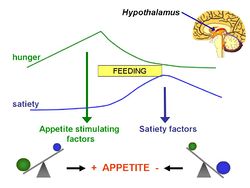Aminostatic hypothesis: Difference between revisions
imported>Ro Thorpe m (moved The Aminostatic Hypothesis to The aminostatic hypothesis) |
imported>Lisa Robertson |
||
| Line 6: | Line 6: | ||
==References== | ==References== | ||
{{reflist | 2}} | {{reflist | 2}} | ||
Comparison of 2 diets with either 25% or 10% of energy as casein on | |||
energy expenditure, substrate balance, and appetite profile1–3 | |||
Ananda Hochstenbach-Waelen, Margriet AB Veldhorst, Arie G Nieuwenhuizen, Margriet S Westerterp-Plantenga, | |||
and Klaas R Westerterp | |||
Protein Intake, Brain Amino Acid and Serotonin | |||
Concentrations and Protein Self-Selection1'2 | |||
ALFRED E. HARPER f* ANDJOHN C. PETERS | |||
The Effects of High Protein Diets on Thermogenesis, | |||
Satiety and Weight Loss: A Critical Review | |||
Protein, amino acids and the control of food intake | |||
Daniel Tome* | |||
Unite´ INRA 914 Physiologie de la Nutrition et du Comportement Alimentaire, Institut National Agronomique Paris-Grignon, | |||
16, rue Claude Bernard, 75231 Paris cedex 05, France | |||
Influences of protein to energy ratios in breakfast on mood, alertness and attention in the healthy undergraduate students | |||
Yao-Chi Zeng1*, Shun-Min Li1, Guo-Liang Xiong1, Hui-Min Su2, Jian-Cheng Wan3 | |||
Revision as of 06:27, 4 October 2011
For the course duration, the article is closed to outside editing. Of course you can always leave comments on the discussion page. The anticipated date of course completion is 01 April 2012. One month after that date at the latest, this notice shall be removed. Besides, many other Citizendium articles welcome your collaboration! |
In 1956, Mellinkoff proposed the aminostatic hypothesis, stimulated by the observation that when normal individuals ingest protein, appetite diminishes as the serum amino acid concentration rises and vice versa.[1]
References
- ↑ Mellinkoff SM et al. (1956) Relationship between serum amino acid concentration and fluctuations in appetite J Appl Physiol 8:535-8 PMID 13295170
Comparison of 2 diets with either 25% or 10% of energy as casein on energy expenditure, substrate balance, and appetite profile1–3 Ananda Hochstenbach-Waelen, Margriet AB Veldhorst, Arie G Nieuwenhuizen, Margriet S Westerterp-Plantenga, and Klaas R Westerterp
Protein Intake, Brain Amino Acid and Serotonin Concentrations and Protein Self-Selection1'2 ALFRED E. HARPER f* ANDJOHN C. PETERS
The Effects of High Protein Diets on Thermogenesis, Satiety and Weight Loss: A Critical Review
Protein, amino acids and the control of food intake Daniel Tome* Unite´ INRA 914 Physiologie de la Nutrition et du Comportement Alimentaire, Institut National Agronomique Paris-Grignon, 16, rue Claude Bernard, 75231 Paris cedex 05, France
Influences of protein to energy ratios in breakfast on mood, alertness and attention in the healthy undergraduate students Yao-Chi Zeng1*, Shun-Min Li1, Guo-Liang Xiong1, Hui-Min Su2, Jian-Cheng Wan3
